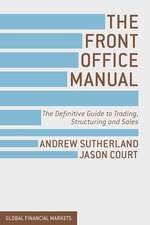The Validation of Risk Models: A Handbook for Practitioners: Applied Quantitative Finance
Autor S. Scandizzoen Limba Engleză Hardback – 27 apr 2016
Preț: 779.45 lei
Preț vechi: 906.34 lei
-14% Nou
Puncte Express: 1169
Preț estimativ în valută:
149.19€ • 162.11$ • 125.40£
149.19€ • 162.11$ • 125.40£
Carte tipărită la comandă
Livrare economică 21 aprilie-05 mai
Preluare comenzi: 021 569.72.76
Specificații
ISBN-13: 9781137436955
ISBN-10: 1137436956
Pagini: 400
Ilustrații: VIII, 242 p.
Dimensiuni: 155 x 235 x 23 mm
Greutate: 0.54 kg
Ediția:1st ed. 2016
Editura: Palgrave Macmillan UK
Colecția Palgrave Macmillan
Seria Applied Quantitative Finance
Locul publicării:London, United Kingdom
ISBN-10: 1137436956
Pagini: 400
Ilustrații: VIII, 242 p.
Dimensiuni: 155 x 235 x 23 mm
Greutate: 0.54 kg
Ediția:1st ed. 2016
Editura: Palgrave Macmillan UK
Colecția Palgrave Macmillan
Seria Applied Quantitative Finance
Locul publicării:London, United Kingdom
Cuprins
Introduction: A Model Risk Primer
PART I: A FRAMEWORK FOR RISK MODEL VALIDATION
1. Validation, governance and supervision
2. A validation framework for risk models
PART II: CREDIT RISK
3. Credit risk models
4. Probability of default models
5. Loss Given Default models
6. Exposure at Default models
PART III: MARKET RISK
7. Value at risk models
8. Interest rate risk on the banking book
PART IV: COUNTERPARTY CREDIT RISK
9. Counterparty Credit Risk Models
PART V: OPERATIONAL RISK
10. The validation of AMA models
11. Use test for operational risk
PART VI: PILLAR 2 MODELS
12. Economic capital models
13. Stress testing models
14. Conclusion
PART I: A FRAMEWORK FOR RISK MODEL VALIDATION
1. Validation, governance and supervision
2. A validation framework for risk models
PART II: CREDIT RISK
3. Credit risk models
4. Probability of default models
5. Loss Given Default models
6. Exposure at Default models
PART III: MARKET RISK
7. Value at risk models
8. Interest rate risk on the banking book
PART IV: COUNTERPARTY CREDIT RISK
9. Counterparty Credit Risk Models
PART V: OPERATIONAL RISK
10. The validation of AMA models
11. Use test for operational risk
PART VI: PILLAR 2 MODELS
12. Economic capital models
13. Stress testing models
14. Conclusion
Notă biografică
Sergio Scandizzo is the Head of Model Validation at the European Investment Bank (EIB) in Luxembourg. He is the author of Risk and Governance: A Framework for Banking Organisations; The Operational Risk Manager's Guide, now in its second edition, and of Validation and Use Test in AMA. He is Associate Editor of The Journal of Operational Risk and has published several journal papers on fuzzy logic, genetic algorithms and risk management.
Textul de pe ultima copertă
The practice of quantitative risk management has reached unprecedented levels of sophistication. The pricing, the assessment of risk as well as the computation of the capital requirements for highly complex transactions are performed through equally complex mathematical models, running on sophisticated computer systems, developed and operated by dedicated, highly qualified specialists. With this sophistication, however, come risks that are unpredictable, globally challenging and difficult to manage. Model risk is a prime example of these and precisely the kind of risk that those tasked with managing financial institutions as well as those overseeing the soundness and stability of the financial system should worry about.
This book starts with setting the problem of the validation of risk models within the context of banking governance and proposes a comprehensive methodological framework for the assessment of models against compliance, qualitative and quantitative benchmarks. It provides a comprehensive guide to the tools and techniques required for the qualitative and quantitative validation of the key categories of risk models and introduces a practical methodology for the measurement of the resulting model risk and its translation into prudent adjustments to capital requirements and other estimates.
This book starts with setting the problem of the validation of risk models within the context of banking governance and proposes a comprehensive methodological framework for the assessment of models against compliance, qualitative and quantitative benchmarks. It provides a comprehensive guide to the tools and techniques required for the qualitative and quantitative validation of the key categories of risk models and introduces a practical methodology for the measurement of the resulting model risk and its translation into prudent adjustments to capital requirements and other estimates.
Caracteristici
Fully uptodate: It will be entirely focused on the models used in today's risk management practice and as such will constitute a onestopshop for professionals involved in the validation of risk management models Comprehensive: It will be comprehensive: it will cover the whole spectrum of risks, across the technical (market, credit, operational, liquidity, counterparty, etc.) as well as the regulatory categories (Basel Accord II, 2.5, III, Pillar 1, Pillar Market focussed: this will be a practical manual showing how things are actually done in practice both in terms of processes to be set up for validation and in terms of tools and techniques, with a special focus on practical challenges and solutions

























